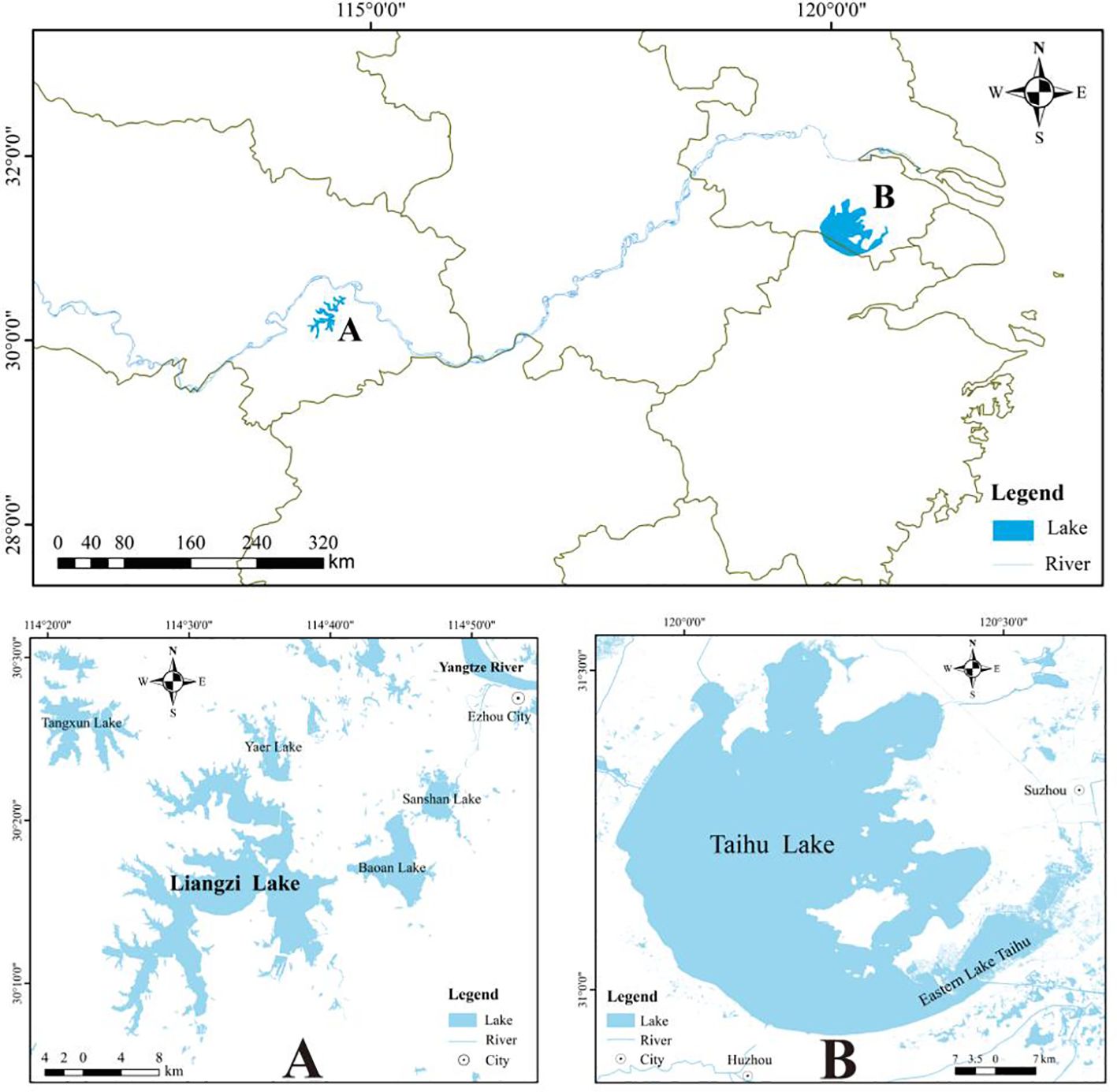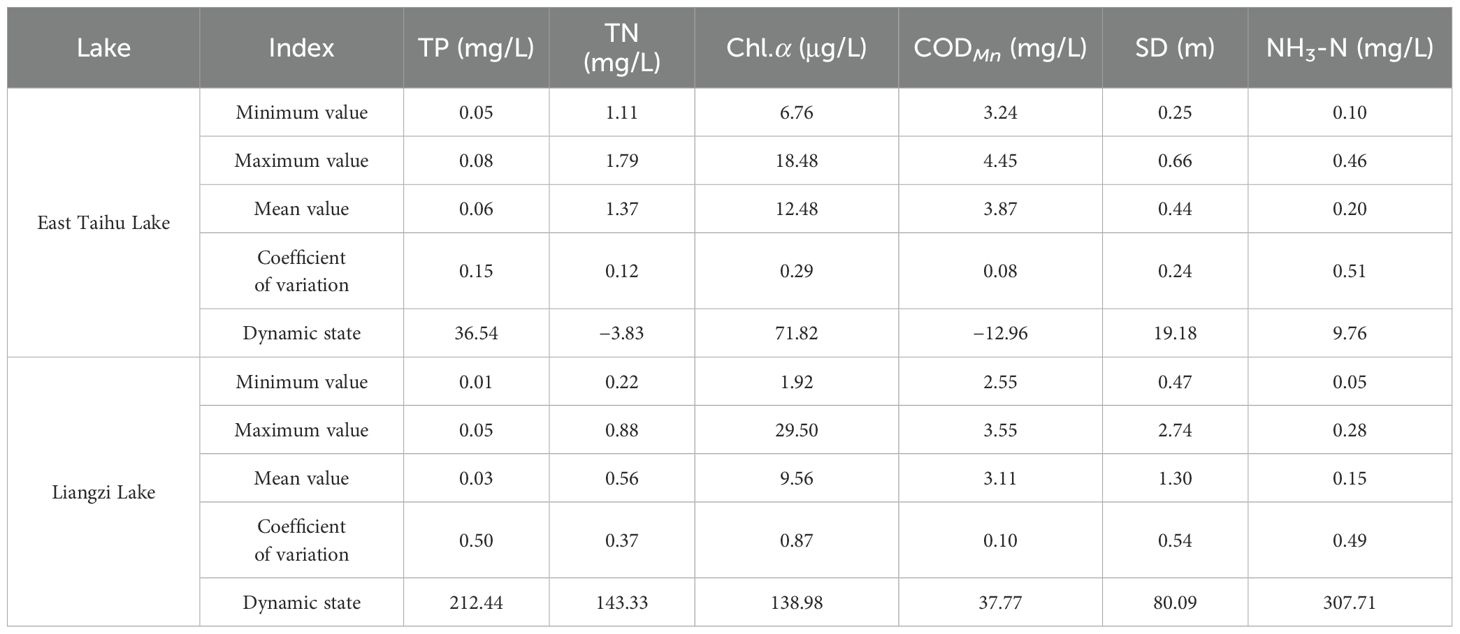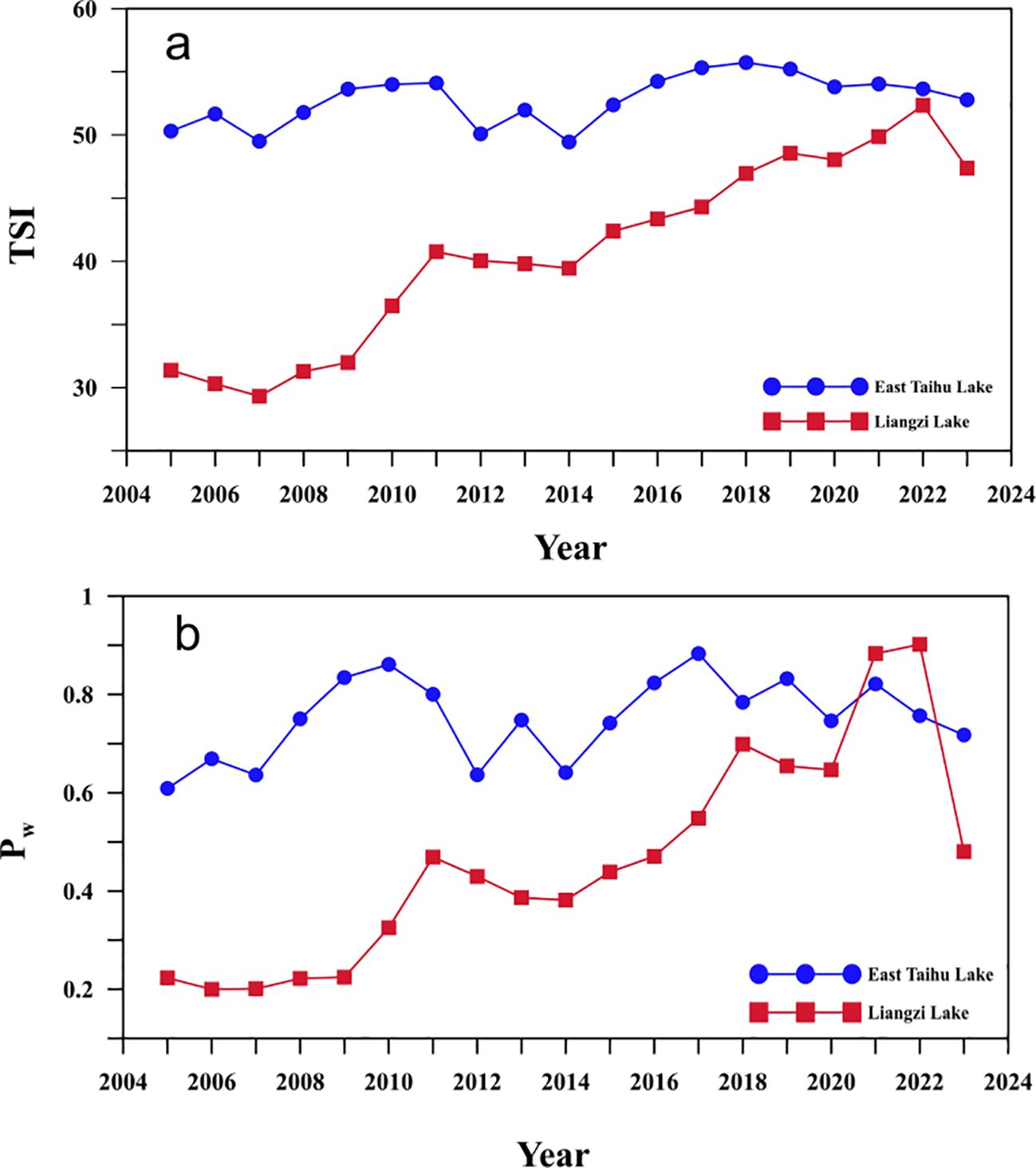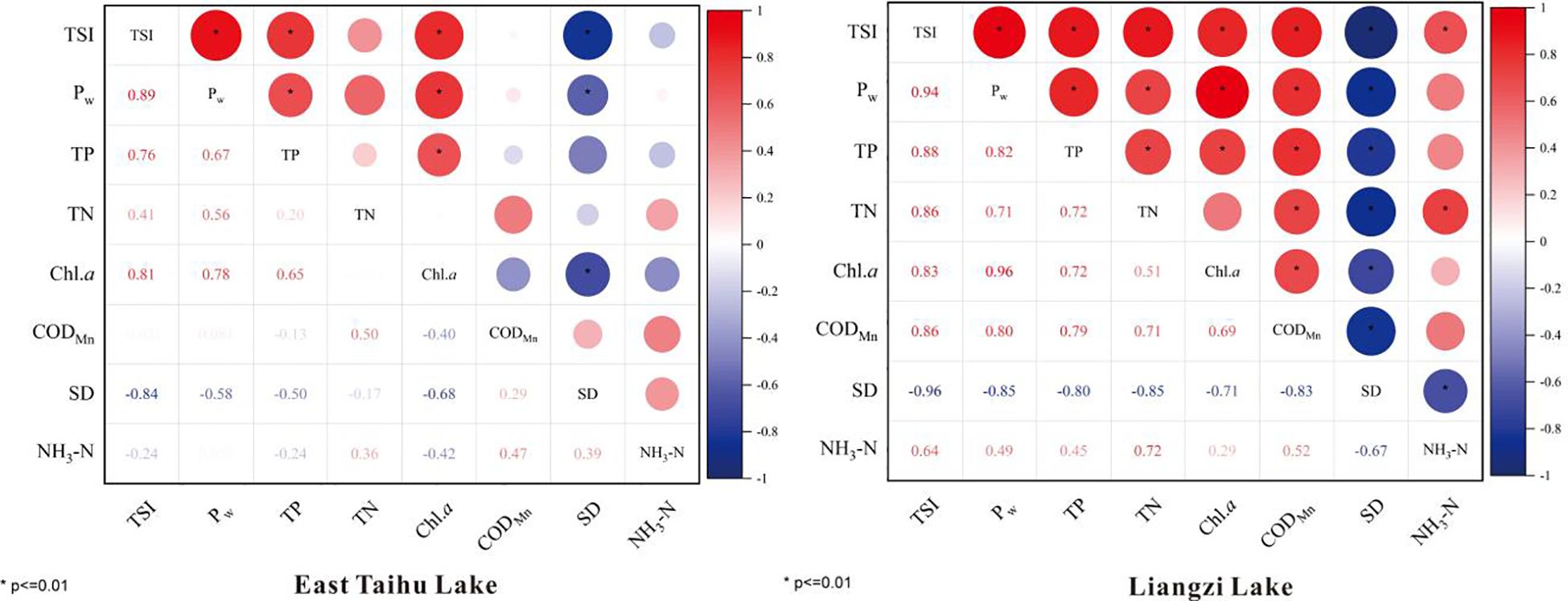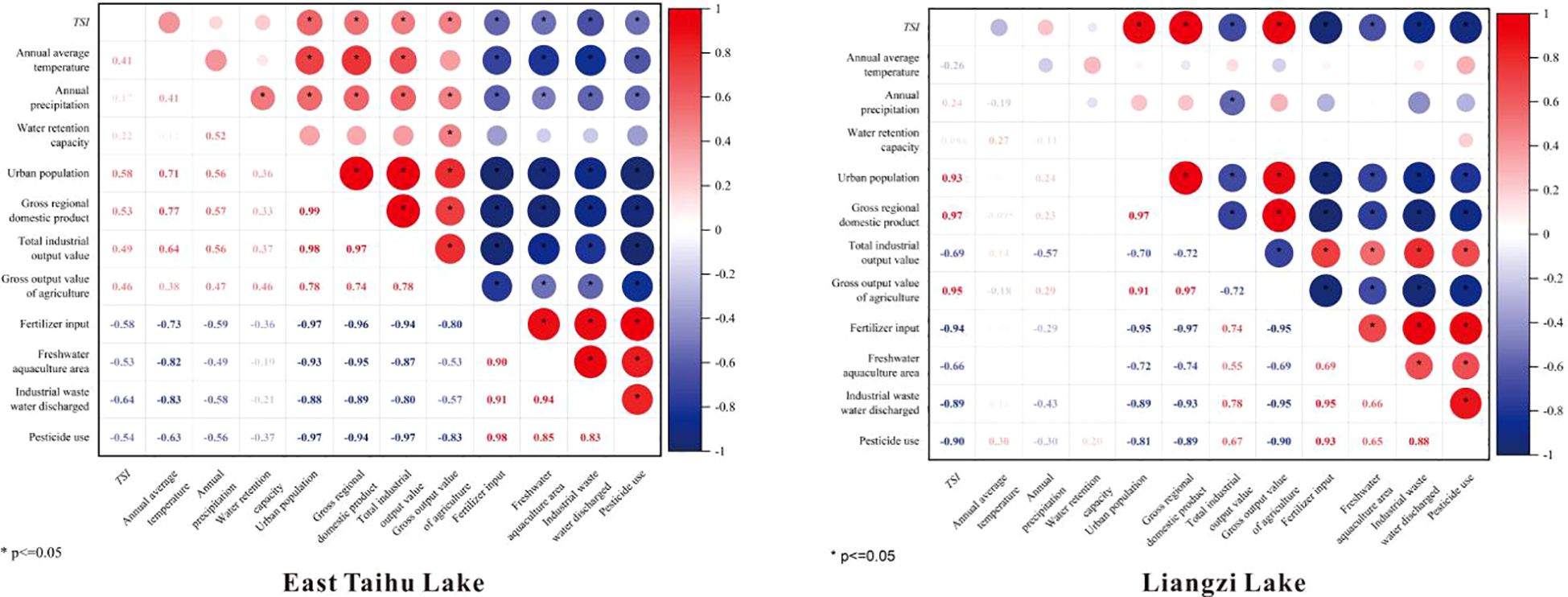- 1School of Environmental Sciences, Nanjing Xiaozhuang University, Nanjing, China
- 2State Key Laboratory of Lake Science and Environment, Nanjing Institute of Geography and Limnology, Chinese Academy of Sciences, Nanjing, China
- 3School of Geographical Sciences, Nanjing University of Information Science and Technology, Nanjing, China
Water quality degradation threatens macrophyte-dominated lake ecosystems, necessitating systematic analysis of spatiotemporal patterns and anthropogenic drivers. This study examines two macrophytic lakes (East Taihu and Liangzi Lake) using water quality monitoring data (2005–2023) through trophic state index (TSI), comprehensive pollution index (Pw), and dynamic change analyses. The results reveal divergent trends: East Taihu Lake exhibited an increase in chlorophyll α, total phosphorus (TP), and ammonia-nitrogen (NH3-N), while total nitrogen (TN), permanganate index (CODMn), and secchi depth (SD) exhibited a decline. Prior to 2018, the TSI and Pw of East Taihu Lake exhibited an upward trend; however, after 2018, they demonstrated a gradual decline. Notably, the TSI of East Taihu Lake persists at a relatively elevated level (TSI > 50), thus being classified as eutrophic, with TP identified as the predominant contributor to water pollution (p< 0.01). All water quality indexes, TSI, and Pw of Liangzi Lake have shown an upward trend, but its TSI and Pw are lower than those of East Taihu Lake, being mesotrophic (30< TSI< 50), but in some stages it is close to eutrophic. CODMn and TP dominated Liangzi’s pollution (p< 0.01). Correlation analyses have identified intensive anthropogenic activities, including population growth, agricultural/industrial expansion, fertilizer/pesticide use, wastewater discharge, and cage aquaculture expansion – as key drivers of water quality deterioration. Meanwhile, the increase in nutrient concentrations and the outbreak of cyanobacterial blooms caused by the release of endogenous pollutants should not be overlooked. Effective restoration requires integrated strategies. These include: 1) controlling external pollutant loads, especially phosphorus inputs, 2) optimizing aquatic vegetation and fish communities, and 3) strengthening lake management regulations. These measures are essential for the restoration of the clear and stable state of macrophyte-dominated lakes.
1 Introduction
Lakes represent a vital component of the terrestrial surface ecosystem, functioning as a critical conduit for water resources (Dearing et al., 2012; Messager et al., 2016). They fulfill a variety of functions, including water conservancy, flood control, water supply, and climate regulation, and play an instrumental role in the development of society and economy (Zhang et al., 2023). Nevertheless, over the past century, anthropogenic activities and climate change have collectively driven global environmental changes that are significantly impacting lake catchment systems (Gullian et al., 2021). The increase in nutrient inputs into the catchment has led to the eutrophication of many lakes, resulting in frequent algal blooms and deteriorating water quality. This has caused the degradation of macrophytic lake ecosystems and the formation of algal lake ecosystems (Scheffer et al., 1993). Presently, lake eutrophication stands as the most pressing environmental challenge in China (Zhang et al., 2022). Despite the implementation of various restoration and governance measures by governments at all levels, the eutrophication status of most lakes has not been completely improved (Qin et al., 2020b, Qin et al., 2022).
The middle and lower reaches of the Yangtze River (MLYR) exhibit a globally exceptional density of freshwater lakes, a defining hydrological characteristic that differentiates this region from other major river basins in China and worldwide. These lakes, which are shallow in nature, are found along the floodplain and have played a significant role in the region’s environmental history. Nonetheless, as a consequence of anthropogenic activities within the region, a substantial quantity of nutrients, such as nitrogen and phosphorus, has been discharged into the lakes within the basin, resulting in an accelerated eutrophication rate of the lakes in this area (Li et al., 2018). Concurrently, a substantial proportion of exogenous nutrients entering the lake are precipitated and accumulated in the bottom sediment, thereby converting into a considerable endogenous potential (Qin, 2020a). Additionally, wind and waves generate substantial suspension of the sediment, resulting in the release of a considerable amount of nutrients. This phenomenon effectively facilitates the growth of algae and leads to the outbreak of cyanobacterial blooms (Zhu et al., 2014). As Qin et al. (2022) observed, although there has been a significant improvement in the water quality of the main stream of the Yangtze River from 2008 to 2018, there has been no improvement in the water quality and biodiversity of the lakes within the basin. In fact, the total nitrogen (TN) and total phosphorus (TP) content of these lakes has been continuously rising. Furthermore, the degradation of aquatic plant communities is also another crucial environmental problem confronted by the lakes within the MLYR. When aquatic plants are degraded, they can cause a decline in biodiversity and the loss of some ecosystem services, severely limiting the development of social and economic activities in the watershed (Carpenter and Lodge, 1986; Lin et al., 2019). Research findings indicate a substantial area of aquatic plants in Honghu Lake, Liangzi Lake, Caizi Lake, and Changhu Lake in the MLYR, has been lost over an expanse of 100 km² (Zhang et al., 2017). Consequently, conducting research on the long-term water quality degradation process of typical macrophyte-dominated lakes is of significant practical importance for the ecological protection and governance of such bodies of water.
This paper employs a systematic approach, integrating both literature and monitoring data, to comprehensively analyze the water quality change process of two notable macrophyte-dominated lakes, East Taihu Lake and Liangzi Lake, situated within the MLYR. The study encompasses the period since 2005 to 2023 and utilizes a multifaceted approach to assess the primary drivers of water quality degradation. The overarching objective of this study is to provide a scientific foundation and theoretical underpinnings to support the conservation and management of lakes within the MLYR.
2 Materials and methods
2.1 Study area
The East Taihu Lake (30°58’–31°07’ N, 120°25’–120°35’ E) is located on the southeast side of the Dongting Peninsula in Suzhou of Taihu Lake (Liu et al., 2023). As a typical macrophyte-dominated lake, it covers an area of 131 km2 with an average water depth of 0.89 m (Figure 1B). East Taihu Lake is ecologically critical for biodiversity conservation, functioning as both a fish breeding reserve and a commercial fishery base. Additionally, it serves as a vital water source for downstream regions, including Shanghai (Li et al., 2023). Liangzi Lake (30°04’–30°19’ N, 114°22’–114°39’ E), situated on the southern bank of the middle reaches of the Yangtze River, is Hubei Province’s second-largest freshwater lake (Zhang et al., 2018). Spanning 340 km2 with an average depth of 2.5 m (Figure 1A), it harbors an intact ecosystem recognized as one of China’s best-preserved freshwater biodiversity hotspots (Wu et al., 2024).
These two lakes represent rare surviving macrophyte-dominated ecosystems in the MLYR. However, in recent years, rapid socioeconomic development and unsustainable human exploitation have severely degraded their aquatic environments (Wu et al., 2000; Zhang et al., 2018; Liu et al., 2023). Consequently, investigating long-term water quality trends and their drivers in these lakes is therefore essential for guiding ecological restoration of macrophyte-dominated freshwater systems.
2.2 Data sources
Quantifying lake eutrophication levels is critical for designing effective conservation strategies. The index system that has been developed encompasses chemical indexes, including TN, TP, and ammonia-nitrogen (NH3-N) concentrations, as well as impact indexes such as secchi depth (SD), the permanganate index (CODMn), and related parameters of phytoplankton (e.g., chlorophyll-α, which reflects biomass) and aquatic macrophytes (Carlson, 1977; Trimbee and Prepas, 1987; Hautier et al., 2009). In the study of lake water quality, TN and TP have been identified as the primary drivers of eutrophication, with their input fluxes determining the overall productivity of the ecosystem. Chlorophyll a (Chl.α) directly corresponds to algal biomass, and its peak value indicates the risk of algal bloom. NH3-N, a byproduct of agricultural non-point sources, aquaculture, and urban sewage input, can be traced back to these respective origins. Its concentration dynamics reflect the nitrogen cycling process. SD reflects the density of algae and the loading of suspended matters through the light attenuation coefficient. CODMn, an indicator of organic pollution, is identified through oxidation-reduction characteristics. Its spatiotemporal heterogeneity analysis provides insights into the transport law of pollutants. The integration of these six parameters enables the quantification of the cascading effect of “external input – internal release – algal response,” thereby providing a scientific foundation for evaluating the nutritional status of lakes (Carlson, 1977; Jin and Tu, 1990). Specifically, the CODMn and NH3-N serve as pivotal indicators in the trophic state index method (TSI) and the comprehensive pollution index method (Pw), respectively (Jin and Tu, 1990). These indicators are instrumental in characterizing the eutrophication of lakes. Hence, this study focuses on six key parameters – TN, TP, Chl.α, NH3-N, SD, and CODMn – as proxies for water quality trends in the target lakes.
Water quality data for East Taihu Lake (2005–2020) were obtained from the Lake-Watershed Science Data Center, National Earth System Science Data Center, National Science & Technology Infrastructure of China (http://lake.geodata.cn). Data from 2021–2023 were provided by the Taihu Laboratory for Lake Ecosystem Research, Chinese Ecosystem Research Network. All the aforementioned water quality monitoring data are the average values of the variations within the year. For Liangzi Lake, historical data (2005–2022) were extracted from Wu et al. (2024) using Grapher 10 (Version 10.0, Golden Software, USA), based on annual means from two national monitoring stations in the eastern and western lake basins. The 2023 data were digitized from field measurements by Hou (2023) using the same software. The meteorological and socio-economic data of East Taihu Lake from 2005 to 2023 were obtained from the Statistical Yearbook of Suzhou City (https://www.suzhou.gov.cn/szsrmzf/tjnj/). The data concerning the variations in water storage volume of Taihu Lake from 2005 to 2023 are derived from the Taihu Basin Authority of Ministry of Water Resources (https://www.tba.gov.cn/slbthlyglj/szygb/szygb.html). The data for Liangzi Lake from 2005 to 2022 were obtained from the Statistical Yearbook of Wuhan City (https://tjj.wuhan.gov.cn/tjfw/tjnj/). Note that Wuhan City has not yet published its socio-economic development data for the year 2023. The data concerning the variations in the water storage volume of Liangzi Lake from 2005 to 2023 was derived from the water resources bulletins issued by the Water Resources Department of Hubei Province (https://slt.hubei.gov.cn/bsfw/cxfw/szygb/index.shtml).
2.3 Data analysis
Presently, the most widely employed approach for assessing the eutrophication level of lakes is the TSI, which utilizes the parameters of TN, TP, SD, CODMn, and Chl.α. Therefore, the TSI method was used to evaluate the eutrophication status of water bodies. The formula is presented as follows:
where TSI (∑) is the comprehensive TSI; TSI (j) is the TSI of the j-th parameter; and Wj is the relevant weight of the TSI of the j-th parameter (Equation 1). The calculation formulas and classification criteria for the TSI of each parameter are in accordance with the “Survey Standards of Lake Eutrophication” (2nd Edition) (Jin and Tu, 1990). The determination of the weights of each indicator index is primarily based on the statistical correlation between each water quality parameter and the benchmark parameter (typically Chl.α). These weights are then normalized in combination with the characteristics of the measured data from 26 lakes in China. The weights assigned to Chl.α, TP, TN, SD, and CODMn are 0.2663, 0.1879, 0.1790, 0.1834, and 0.1834, respectively (Jin and Tu, 1990). A numerical scale ranging from 0 to 100 is utilized to assess the trophic state of lakes. The classification of the trophic status of lakes is presented in Table 1.
Concurrently, the Pw was employed to assess the quality of the water. The selection of indexes for this evaluation included TP, TN, Chl.α, CODMn, and NH3-N, which were then utilized in the calculation process. The calculation formula is presented as follows:
where Pi denotes the pollution index of water quality factor i, Ci represents the measured concentration of water quality factor i, Li refers to the Class III standard value of water quality factor i in the “Surface Water Environmental Quality Standards” (GB 3838-2002), n indicates the number of water quality factors, and Pw stands for the comprehensive pollution index (Equations 2, 3).
The dynamic state analysis method was employed to analyze the variation in water quality of the two lakes within the research period, according to the comprehensive pollution index of the lakes in different periods. The calculation formula is presented as follows:
where S denotes the dynamic degree of the comprehensive pollution index of the lake within the specified study period. Pm is the comprehensive pollution index of the lake in the final year, and Pn represents the comprehensive pollution index of the lake in the initial year (Equation 4).
The inter-annual variation trends of various water quality indexes and TSI from 2005 to 2023 were plotted using Grapher 10 (Golden Software, Colorado, USA). To further explore the major influencing factors of water quality changes in the two lakes, the Correlation Plot plugin in Origin 2021 software (Golden Software, Colorado, USA) was used to perform Pearson correlation analysis between water quality indices and climatic/socioeconomic data (p< 0.05).
3 Results
3.1 The characteristics of water quality variation in East Taihu Lake and Liangzi Lake
This paper employs six water quality indices-TN, TP, Chl.α, CODMn, SD, and NH3-N-to characterize nutrient concentrations, organic matter levels, and eutrophication status in two lakes. The temporal variations of these indices in East Taihu Lake over the past two decades are presented in Table 2 and Figure 2. From 2005 to 2023, the mean values (± standard deviation) of TP, TN, Chl.α, CODMn, SD, and NH3-N were 0.06 ± 0.01 mg/L, 1.37 ± 0.17 mg/L, 12.48 ± 3.60 μg/L, 3.87 ± 0.31 mg/L, 0.44 ± 0.11 m, and 0.20 ± 0.10 mg/L, respectively (Table 2). The overall dynamic indices of comprehensive pollution for TP, Chl.α, SD, and NH3-N exhibited positive values, indicating a gradual deterioration in water quality (Table 2, Figures 2a, b, d, f). Notably, Chl.α showed the most pronounced increase, with an overall dynamic index of 71.82. In contrast, negative dynamic indices for TN and CODMn suggested improvements in these parameters (Table 2, Figures 2c, e). Additionally, NH3-N and Chl.α displayed the highest inter-annual coefficients of variation (0.51 and 0.29, respectively), whereas CODMn showed the lowest variation (0.08) (Table 2).
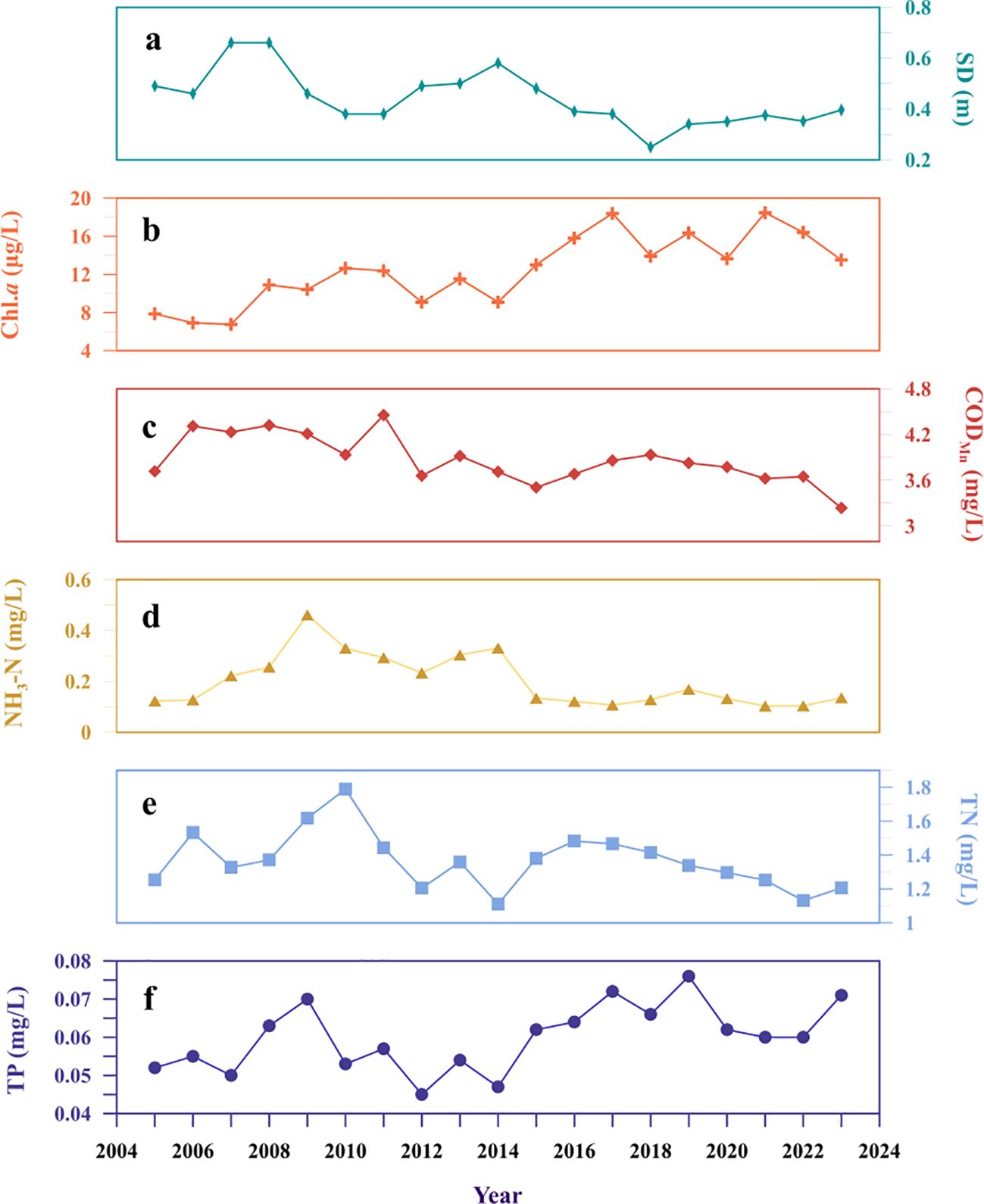
Figure 2. The variation of main water quality indexes in East Taihu Lake from 2005 to 2023. (a) depicts the SD of water bodies (m), (b) represents the Chl.α concentration in water bodies (µg/L), (c) stands for the CODMn (mg/L), (d) denotes the NH3-N concentration of water bodies (mg/L), and (e, f) respectively signify the TN and TP concentrations of water bodies (mg/L).
For Liangzi Lake, the mean values of TP, TN, Chl.α, CODMn, SD, and NH3-N during the same period were 0.03 ± 0.01 mg/L, 0.56 ± 0.21 mg/L, 9.56 ± 8.34 μg/L, 3.11 ± 0.32 mg/L, 1.30 ± 0.70 m, and 0.15 ± 0.08 mg/L, respectively (Table 2). All overall dynamic indices of comprehensive pollution in Liangzi Lake remained positive, reflecting persistent water quality degradation (Table 2, Figure 3). Chl.α exhibited the highest inter-annual variability, reaching 0.87, while CODMn showed minimal variation, at 0.10 (Table 2). Comparative analysis revealed that, except for SD, all water quality parameters in Liangzi Lake were lower than those in East Taihu Lake (Table 2). This observation suggests that the pollution level in Liangzi Lake may be lower than that of East Taihu Lake.
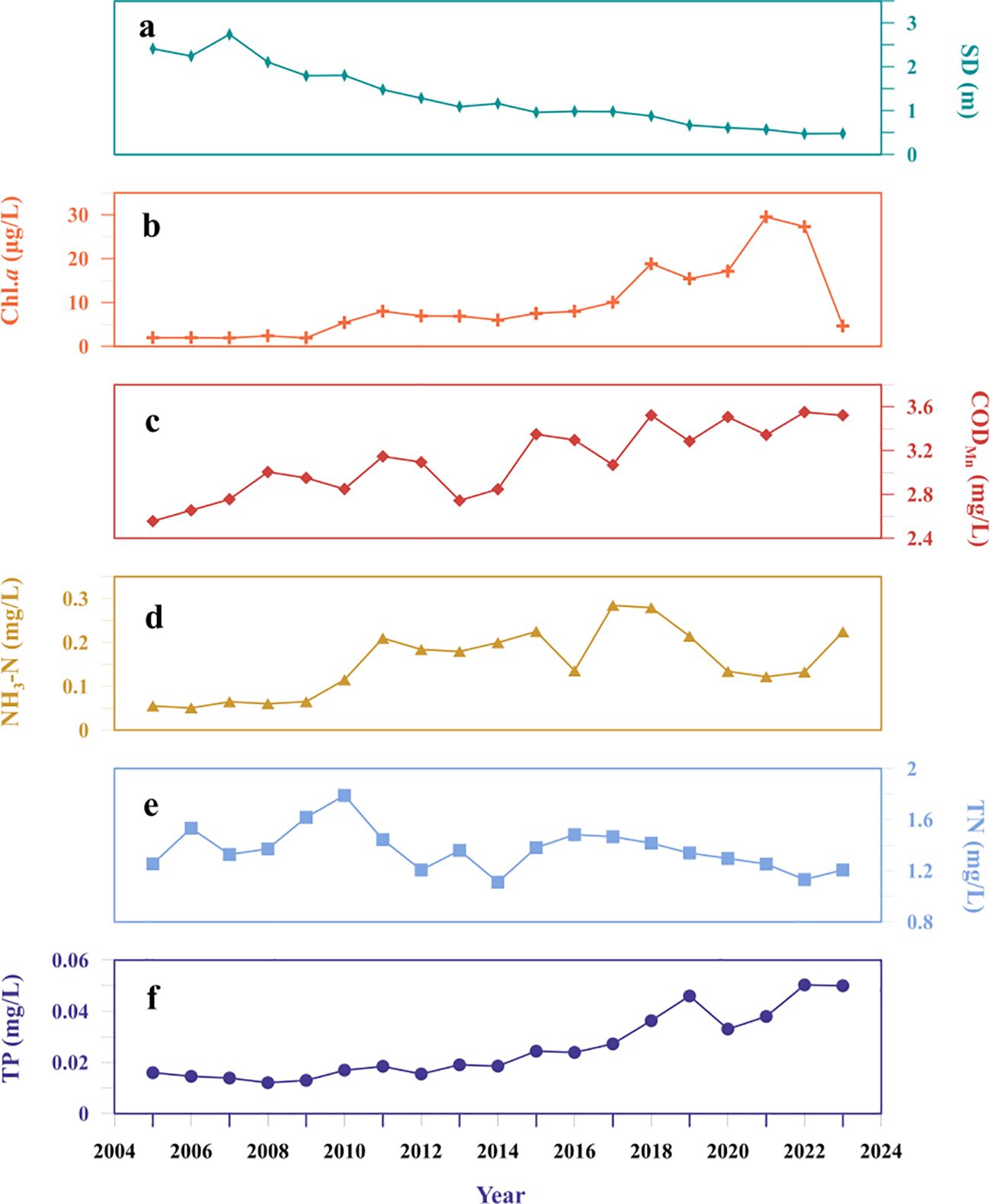
Figure 3. The variation of main water quality indexes in Liangzi Lake from 2005 to 2023. (a) depicts the SD of water bodies (m), (b) represents the Chl.α concentration in water bodies (μg/L), (c) stands for the CODMn (mg/L), (d) denotes the NH3-N concentration of water bodies (mg/L), and (e, f) respectively signify the TN and TP concentrations of water bodies (mg/L).
3.2 The changes of nutritional status in East Taihu Lake and Liangzi Lake
As shown in Figure 4a, the TSI of East Taihu Lake ranges from 49.45 to 55.73, with an average of 52.83 between 2005 and 2023. The time series data revealed a fluctuating upward trend until 2018, followed by a gradual decline, though values remained above 50 throughout the study period (Figure 4a). According to the Technical Specifications for Eutrophication Assessment and Classification of Lakes (Reservoirs) (China National Environmental Monitoring Centre, 2001), East Taihu Lake is classified as eutrophic (TSI (∑) > 50). In contrast, Liangzi Lake exhibited a TSI range of 29.33–52.36 (mean = 40.75), with an overall upward trend characterized by rapid increases before 2011 and gradual rises thereafter (Figure 4a). Its trophic state remained mesotrophic but showed a tendency to transition toward eutrophic conditions (30 ≤ TSI (∑)< 50). The Pw variation range of East Taihu Lake ranged from 0.61 to 0.88, with an average of 0.75, showing a predominantly upward trend from 2005 to 2017 and a decline after 2018 (Figure 4b). For Liangzi Lake, Pw varied between 0.20 and 0.90 (mean = 0.46), with three distinct peaks observed in 2011, 2018, and 2021 (Figure 4b). Comparative analysis revealed similar temporal patterns in TSI and Pw trends between the two lakes from 2005 to 2023. However, East Taihu Lake consistently exhibited higher pollution levels than Liangzi Lake, as evidenced by elevated TSI and Pw values (Figure 4).
3.3 The determination of key water quality indexes for the TSI and Pw
Pearson correlation analysis was performed between water quality indices and TSI, Pw. In the correlation matrix (Figure 5), the circle area and color intensity represent the correlation strength, with larger/darker circles indicating stronger correlations and smaller/lighter circles denoting weaker associations. In East Taihu Lake, a significant positive correlation between TSI, Chl.α and TP (p< 0.01) was observed, along with a negative correlation with SD (Figure 5). These findings imply a close relationship between water eutrophication and the presence of algae and phosphorus in the water. In a similar vein, the correlation between Pw and water quality indexes exhibited a consistency with that of TSI, manifesting a significant positive correlation with Chl.α and TP, and a negative correlation with SD (Figure 5). These results indicate pronounced eutrophication in East Taihu Lake, with TP being a critical exceeding environmental thresholds.
In Liangzi Lake, TSI was significantly positively correlated with TP, TN, CODMn, Chl.α, and NH3-N (p< 0.01), but negatively correlated with SD, suggesting nutrient and organic matter enrichment drive eutrophication (Figure 5). The correlation between Pw and water quality indexes exhibited a nearly identical pattern to that of TSI, demonstrating a significant positive correlation with TP, TN, CODMn, and Chl.α, and a negative correlation with SD (Figure 5). This highlights severe eutrophication in Liangzi Lake, primarily driven by excessive TP and CODMn concentrations.
3.4 Analysis of the driving factors for changes in lake water environments
The deterioration of lake water quality is driven by both natural and anthropogenic factors. Natural drivers include climatic variables (e.g., temperature, precipitation), while anthropogenic drivers encompass socioeconomic activities such as urban population growth, regional GDP, and agrochemical usage (fertilizers and pesticides). Utilizing the available data and considering the unique characteristics of the two lakes, this study identifies the annual average temperature, annual precipitation, and water retention capacity as natural driving factors, and the urban population, regional GDP, total industrial and agricultural output value, application amount of chemical fertilizers and pesticides, freshwater aquaculture area, and industrial wastewater discharge within the basin as human activity influencing factors. As demonstrated in Figure 6, the trophic states of East Taihu Lake and Liangzi Lake are predominantly influenced by anthropogenic activities (p< 0.05), with minimal sensitivity to natural drivers. However, it is imperative to acknowledge the potential influence of other factors on the water quality of these lakes. These include natural factors such as climate change and extreme weather events, as well as human activities within the basin, such as land use, and the current quantity and community structure of aquatic plants in the lake body, and the impact of hydrological and hydrodynamic conditions (e.g., the lake’s evaporation rate and drainage capacity) (Figure 7). Given the unavailability of direct data on these factors, it is crucial to acknowledge their role in the overall assessment of lake health.
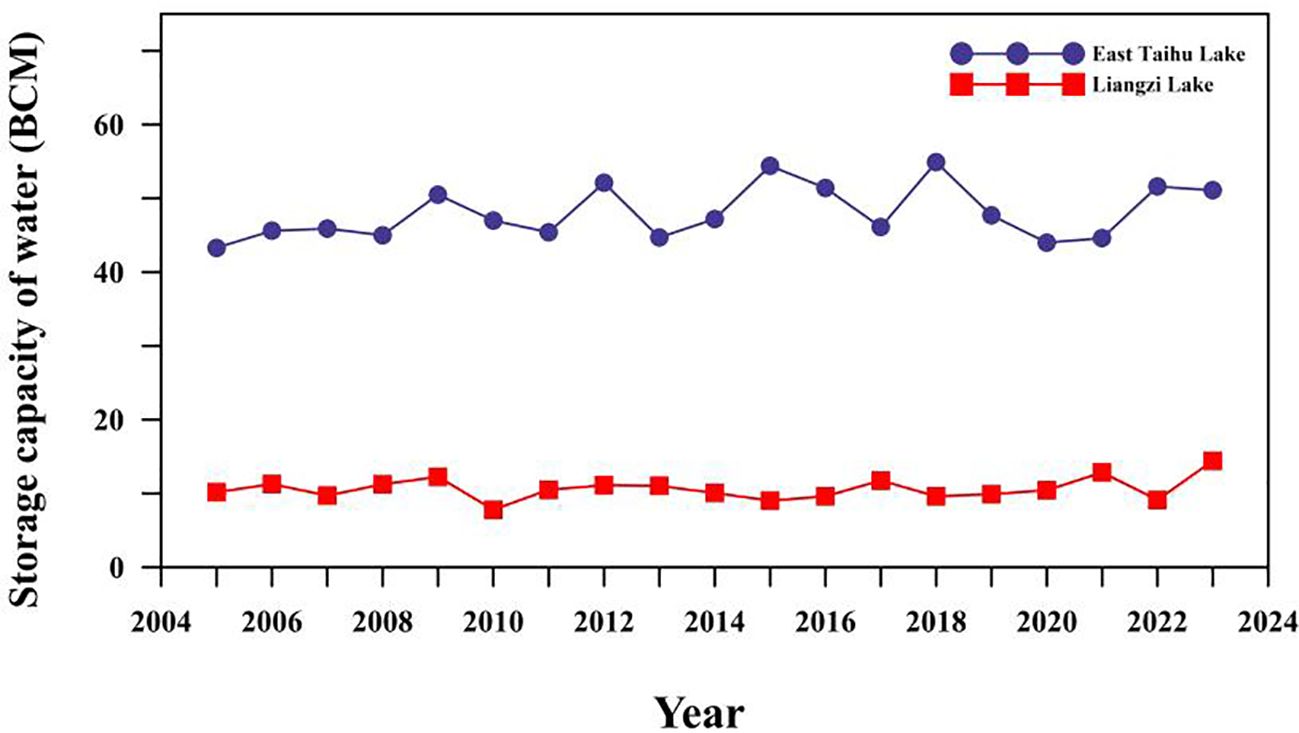
Figure 7. Schematic diagram of the variations in water storage capacity of East Taihu Lake and Liangzi Lake from 2005 to 2023.
4 Discussion
4.1 Analysis of the reasons for water quality degradation in East Taihu Lake
From 2005 to 2023, the water quality indexes of East Taihu Lake exhibited fluctuating changes, primarily characterized by the gradual increase of TP, Chl.α, and NH3-N, while TN, SD, and CODMn underwent a gradual decrease (Figure 2). The decline in the concentrations of TN and CODMn in East Taihu Lake is associated with the implementation of comprehensive water quality governance measures in the Taihu Lake Basin. Since 2010, the Wuzhong District of Suzhou City has been engaged in a comprehensive improvement project of East Taihu Lake. This project has encompassed a variety of initiatives, including the restoration of the ecological shoreline of East Taihu Lake, the reclamation of farmland back to the lake, the construction of ecological wetlands surrounding the lake, and the dredging of branch channels for flood discharge and water supply (Li et al., 2023). Zhu et al.’s (2022) analysis of images depicting the dynamic changes in wetland landscape types in the Taihu Lake Basin from 1990 to 2019 revealed a decrease in the area of constructed land along the eastern shore of Taihu Lake, concurrent with an increase in the wetland area. This phenomenon has been shown to positively impact the water ecological environment of the East Taihu Lake. Therefore, over the past decade, there has been a substantial decrease in the concentrations of various forms of nitrogen in the Taihu Lake water body, with a 35.9% decrease in TN concentration (Gu et al., 2019; Zou et al., 2023). This decline indicates that the pollution control measures implemented in East Taihu Lake, particularly those aimed at source control and sewage interception, have yielded notable outcomes.
Nevertheless, the concentrations of TP, Chl.α, and NH3-N in East Taihu Lake have been showing a consistent upward trend (Figure 2). Concurrently, the TSI of East Taihu Lake has been persistently escalating and is currently in a eutrophic state (Figure 4). The underlying cause of this eutrophication is attributed to a multifaceted array of anthropogenic activities (Figure 6). Firstly, rising population density in the basin has been accompanied by increased discharge of various kinds of sewage and application of chemical fertilizers and pesticides. This intensification of exogenous pollution input into East Taihu Lake has led to elevated levels of TP and NH3-N in the water, thereby exacerbating the degree of water eutrophication (Zhang et al., 2022; Li et al., 2023). For instance, Zhu et al. (2021) found that the persistently high phosphorus concentration in Taihu Lake is related to the increase in the proportion of land used for construction, the growth of population, and the increase in the proportion of cultivated land converted to other uses in the Taihu Lake Basin. While modern wastewater treatment plants exhibit partial contaminant removal efficacy, basin-scale pollutant loads persist at environmentally significant levels, driven primarily by demographic expansion-induced increases in untreated effluent volumes (Qin, 2020a). Secondly, East Taihu Lake is a typical macrophyte-dominated lake. Since 1979, the area dedicated to aquaculture enclosure in this region has been expanding on an annual basis. Aquaculture enclosures have been demonstrated to result in a significant increase in feed and fish excretions (Poersch et al., 2020). Concurrently, the cages impede water flow, consequently precipitating deterioration in water quality and eutrophication. Despite the substantial dismantling of aquaculture enclosures in the East Taihu Lake that occurred in 2018, the impact on water quality remains a concern. Li et al. (2023) systematically collated the monitoring data of nutrients such as nitrogen and phosphorus in the East Taihu Lake over the past 30 years. Their findings indicated that the heightened hydrodynamic activity resulting from the removal of aquaculture enclosures, in conjunction with the release of nutrients from the sediment in the former enclosure aquaculture area, constituted the primary factors contributing to the escalation in nutrient concentrations within the East Taihu Lake. Finally, East Taihu Lake is characterized by its shallow water. Wind-driven waves have been observed to lead to large-scale suspension of sediments and the release of a considerable amount of nutrients (Qin, 2020a). Empirical evidence from field observations conducted during typhoon events has substantiated that the substantial suspension of sediments and the release of nutrients triggered by wind-driven waves significantly promote the proliferation of algae, culminating in the emergence of cyanobacterial blooms (Zhu et al., 2014). Aquatic plants possesses the capacity to immobilize nitrogen and phosphorus within water bodies, thereby regulating the release of nutrients from sediments (Kreiling et al., 2011). This process is achieved by impeding the resuspension of lake bottom sediment, which in turn leads to the enhancement of water quality. In 2002, the East Taihu Lake community was dominated by four species: Potomogeton distinctus, Myriophyllum verticillatum, Hydrilla verticillata, and Myriophyllum verticillatum (Gu et al., 2005). This community comprised a total of 17 species of submerged plants, 13 species of floating-leaved plants, and 9 species of floating plants. However, by 2021, the area of submerged plants in East Taihu Lake had significantly declined, and the aquatic plant community had become monotonous, dominated by floating-leaved plants (Li et al., 2023). This decline in submerged plant has also led to the resuspension of sediment, resulting in an increase in Chl.α and TP concentrations.
4.2 Analysis of the reasons for water quality variation in Liangzi Lake
From 2005 to 2023, all water quality indexes of Liangzi Lake, with the exception of SD, have exhibited an upward trend, and the TSI has also increased on an annual basis (Figures 3, 4a). A multitude of other relevant studies have also attested to the fact that the water quality of Liangzi Lake has been persistently deteriorating in recent years, with the nutrient level increasing gradually. For instance, Ye et al. (2023) employed the single-factor evaluation method and the pollution index method to assess the water quality of Liangzi Lake since the 13th Five-Year Plan. The investigation revealed that the TP, the primary contaminant of Liangzi Lake, exhibited an upward trend, and the source of the pollutants was identified as exogenous input. A study by Hou (2023) revealed a consistent upward trend in the TP and CODMn of Liangzi Lake from 2012 to 2022. The findings of the research on the alterations in the water quality of Liangzi Lake over the past two decades, as presented in this paper, are consistent with the aforementioned observations. Furthermore, this study discovers that TP and CODMn are the predominant pollutants contributing to the degradation of water quality in Liangzi Lake (Figure 5). Zhong et al. (2020) investigated the principal pollution factors of the water environment of Liangzi Lake and likewise affirmed that TP and CODMn are the major pollution factors of Liangzi Lake, with the main pollutants mainly being the input of exogenous contaminants.
Analogous to the East Taihu Lake, anthropogenic activities are the primary drivers of the degradation of water quality and eutrophication in Liangzi Lake (Figure 6). The lake has been subject to a variety of pressures that have contributed to its state of pollution. These pressures include the following: non-point source pollution within the catchment area, and the aquaculture enclosure, etc (Qin et al., 2016; Wu et al., 2024). Firstly, the Liangzi Lake watershed (Jiangxia District) encompasses a drainage area of 169.82 km2 supporting a substantial resident population. Significant non-point source pollution inputs enter the lacustrine system through 17 tributaries, predominantly originating from agricultural runoff, domestic sewage, and industrial effluents (Xiong and Wan, 2008). Water quality parameters at inflow points consistently exceed Grade V thresholds in China’s Surface Water Quality Standard (GB3838-2002), particularly for TN, TP, and CODMn. Agricultural activities constitute the primary pollution source, with seasonal fertilization practices (May–August) driving pronounced nutrient fluxes (Hou, 2023). Surface runoff transports 78–83% of applied nitrogen and 65–72% of phosphorus fertilizers into aquatic systems during summer precipitation events (June–September). This seasonal forcing mechanism results in significantly higher TN and TP concentrations during summer months compared to winter measurements (Qin et al., 2016). Secondly, the aquaculture in Liangzi Lake is comprised of two primary forms: fishery breeding around the lake and cage culture within the lake (Wu et al., 2024). The summer season is characterized by the highest rates of food intake and growth among aquatic organisms. The substantial input of bait results in comparatively elevated concentrations of CODMn and TN (Qin et al., 2016). Conversely, during the autumn harvest season, when the aquatic products reach maturity, the disturbance to the water body is significant, resulting in a relatively high concentration of CODMn. Following the onset of winter, a gradual decline in CODMn concentration is observed. However, the concentration of TN increases due to the decay of excessive bait, animal and plant residues, and their excreta from cage culture within the lake, which directly enter the upper water layer. In 2018, Liangzi Lake implemented a comprehensive fishing ban and removed the encircling nets. Nevertheless, the deterioration of water quality in Liangzi Lake persisted, with the degree of eutrophication gradually intensifying (Figure 3). This indicates that the pollution input from the controlled watershed and the endogenous pollution in Liangzi Lake remained substantial. Ultimately, Liangzi Lake, classified as a macrophytic-type lake, has exhibited a disturbance in its sediment, attributed to the activity of benthic fish. This disturbance has adversely affected the growth of aquatic plants, primarily by damaging their roots and stems (Hou, 2023). The aquatic plant in Liangzi Lake has nearly lost its capacity for natural recovery, resulting in the loss of regulatory control over nutrients in the sediment. This, in turn, renders the water body more vulnerable to endogenous pollution and eutrophication.
4.3 Suggestions on measures for the improvement and governance of lake water quality
As shown in Figures 2–4, recent years have seen the implementation of regulatory measures by both national and local governments, aimed at stringent wastewater pollutant discharge control. This has led to an improvement in the water quality of East Taihu Lake since 2018. For instance, the area of cage aquaculture in East Taihu Lake amounted to 118.56 km2 during the period from 2000 to 2008. Subsequent to 2008, the government initiated a cage rectification project, which resulted in a reduction of the cage aquaculture area to 30 km2. By the close of 2018, the complete elimination of cages had been achieved (Li et al., 2023). Since 2018, the TN and CODMn of East Taihu Lake have decreased by 14% and 17%, respectively, while TP, Chl.α, and NH3-N have increased by 8%, 18%, and 6%, respectively (Figure 2). Similarly, its eutrophication level remains relatively high, and the water quality of Liangzi Lake has continued to deteriorate (Figure 4). The ecological environment of both lakes remains under pressure, with no substantial improvement observed. This phenomenon is not only observed in East Taihu Lake and Liangzi Lake. Qin et al. (2022) conducted a study using the environmental restoration practices of lakes in the Yangtze River Basin as an example and found that while the water quality of the main stream of the Yangtze River had generally improved significantly from 2008 to 2018, the water quality and biodiversity indicators of lakes within the basin had not improved. In light of the research findings presented in this paper and the prevailing conditions in the study area, specific measures have been put forth to enhance and address the water quality issues afflicting the two lakes.
4.3.1 Control the influx of exogenous pollution
In the context of accelerated economic growth, the current status of the basin reveals several salient issues. The concentration and total amount of pollutants, including urban sewage, industrial wastewater, agricultural fertilizers, and pesticides, are relatively high (Qin et al., 2022). Moreover, the discharge standards of sewage treatment facilities are found to be inadequate, resulting in ineffective control of point source pollution. Notwithstanding the implementation of a comprehensive fishing prohibition in Liangzi Lake, there has been no decline in the lake’s water quality; rather, there has been an improvement. The primary factor contributing to this phenomenon is the inadequate management of pollution from agricultural and industrial sources within the basin. Secondly, the treatment rate of non-point source pollution in rural areas of the basin is relatively low. For instance, in the Taihu Lake Basin, only approximately 10% of non-point source pollutants are absorbed by wetlands at present (Qin et al., 2022). The most effective strategy for mitigating non-point source pollution is the implementation of effective land use regulation. In recent years, the pursuit of economic benefits has led to the conversion of a substantial number of paddy fields and other water bodies into dry land, resulting in a notable increase in non-point source loss of phosphorus (Zhu et al., 2021). In light of these challenges, it is imperative to enhance the intensity of external source control in a continuous manner to counteract the deleterious effects of climate change and the internal source release of the lake.
4.3.2 Conduct the optimized regulation of aquatic plants to enhance the self-purification capacity of water bodies
East Taihu Lake and Liangzi Lake are archetypal examples of macrophyte-dominated lakes. However, recent observations indicate a marked shift in the composition of the submerged plant in East Taihu Lake (Luo et al., 2016). The proliferation of floating-leaved plants has precipitated a substantial modification in the community structure of aquatic plants, culminating in an imbalance within the ecosystem. A comparable phenomenon has been documented in Liangzi Lake, where the preponderance of aquatic vegetation has also been observed to become extinct (Wu et al., 2024). Aquatic macrophytes, particularly submerged plants, drive self-purification in shallow lakes through nutrient absorption and enhanced sedimentation. According to the diversity-stability theory, in areas currently devoid of aquatic plants, ecological transformation of micro-topography and landforms should be carried out to enhance water transparency and restore submerged plants. In regions dominated by floating-leaved plants, measures such as wave reduction, harvesting of floating-leaved plants, and the expansion of submerged plants should be implemented. In areas where a single type of submerged plant is present, efforts should be made to maintain and regulate the diversity of submerged plants.
4.3.3 Regulate the structure of fish communities in lakes and improve the control capacity over the biomass of phytoplankton
Mao et al. (2020) examined the alterations in the food chain structure of Taihu Lake over the past 15 years and its correlation with cyanobacterial blooms. Their findings indicated that the rise in cyanobacterial biomass in recent years has been accompanied by an increase in the biomass of benthic and planktonic animal-eating fish. The impact of fish on cyanobacterial blooms is comparable to the impact of increased nutrients. To effectively address the issue of cyanobacterial blooms in East Taihu Lake and Liangzi Lake, it is imperative to implement targeted management strategies, such as regulating the fish population structure of these two lakes. Concurrently, a moderate catch of filter-feeding fish should be implemented to utilize their role in enriching the water with nutrients and removing phosphorus from the lake. Furthermore, a judicious harvesting of benthic fish is advised to mitigate the excessive stirring of the lake’s bottom sediment by these species and to curtail the release of sedimentary phosphorus.
4.3.4 Intensify the integrated protection and management of lake basins
The protection and governance of lakes necessitate the cooperation of various functional institutions. To this end, it is imperative to enhance communication and coordination among departments such as natural resources, water conservancy, ecological environment and agriculture. Moreover, systematic planning for lake basins must be implemented. Concurrently, the functions of lake basin management institutions should be reinforced, and cooperation between basins and regions, as well as among regions, should be strengthened. The establishment of an effective consultation and communication mechanism is paramount. The preservation of lakes is inextricably linked to public participation. Popular science publicity about lakes should be strengthened to raise awareness about the public’s role in lake protection and management. Legislative developments are also crucial to enhance the efficacy of China’s legal framework for lake management.
5 Conclusions
This paper employed statistical analysis methods to examine alterations in water quality and their underlying factors in two exemplary macrophyte-dominated lakes, East Taihu Lake and Liangzi Lake, from 2005 to 2023. The findings indicated that the water quality of East Taihu Lake exhibited a gradual decline prior to 2018, followed by a recovery. Nevertheless, the nutrient level remains high, indicating eutrophication, with TP being the primary pollutant. In contrast, the water quality of Liangzi Lake has been gradually deteriorating, with its nutrient level rising steadily, approaching eutrophication but remaining in a mesotrophic state. The nutrient levels in Liangzi Lake are lower than those in East Taihu Lake, with TP and CODMn being the predominant pollutants. Human activities are the primary drivers of the deterioration of water quality and the increase in nutrient levels in both lakes. To address these issues, future efforts should be directed toward enhancing the control of external pollution input, optimizing the aquatic plant community and fish structure, and augmenting the self-purification capacity of the water body. This research is of considerable significance for the governance and restoration of other shallow lakes in the MLYR.
Data availability statement
The raw data supporting the conclusions of this article will be made available by the authors, without undue reservation. Requests to access the datasets should be directed to JL,bGl1amxpYUAxNjMuY29t.
Author contributions
JL: Data curation, Funding acquisition, Investigation, Resources, Software, Writing – original draft, Writing – review & editing. WZ: Data curation, Resources, Writing – review & editing. SL: Data curation, Methodology, Writing – review & editing. XW: Writing – review & editing. XG: Writing – review & editing. SSC: Writing – review & editing. CF: Writing – review & editing.
Funding
The author(s) declare that financial support was received for the research and/or publication of this article. This research was supported by the National Natural Science Foundation of China (42207514), the Natural Science Foundation of the Jiangsu Higher Education Institutions of China (21KJB170014, 24KJB170012), the State Key Laboratory of Lake Science and Environment (2022SKL004), the Jiangsu Provincial Double-Innovation Doctor Program (JSSCBS20220749), the 2024 Student Research Fund Project of Nanjing Xiaozhuang University (2024XSKY015), the Talent Introduction Project of Nanjing Xiaozhuang University, and the Natural Science Foundation of Jiangsu Province (BK20240270).
Acknowledgments
We acknowledge data support from Lake-Watershed Science Data Center, National Earth System Science Data Center, and National Science & Technology Infrastructure of China (http://lake.geodata.cn). We are grateful to Bin Xue for his contributions regarding the supervision, conceptualization, and resources of the manuscript.
Conflict of interest
The authors declare that the research was conducted in the absence of any commercial or financial relationships that could be construed as a potential conflict of interest.
The reviewer JY declared a shared affiliation with the author WZ to the handling editor at the time of review.
Generative AI statement
The author(s) declare that no Generative AI was used in the creation of this manuscript.
Publisher’s note
All claims expressed in this article are solely those of the authors and do not necessarily represent those of their affiliated organizations, or those of the publisher, the editors and the reviewers. Any product that may be evaluated in this article, or claim that may be made by its manufacturer, is not guaranteed or endorsed by the publisher.
References
Carlson R. E. (1977). A trophic state index for lakes. Limnology Oceanography 22, 361–369. doi: 10.4319/lo.1977.22.2.0361
Carpenter S. R., Lodge D. M. (1986). Effects of submersed macrophytes on ecosystem processes. Aquat. Bot. 26, 341–370. doi: 10.1016/0304-3770(86)90031-8
China National Environmental Monitoring Centre. (2001). Available online at: https://www.cnemc.cn/jcgf/shj/.
Dearing J. A., Yang X. D., Dong X. H., Zhang E. L., Chen X., Langdon P. G., et al. (2012). Extending the timescale and range of ecosystem services through paleoenvironmental analyses, exemplified in the lower Yangtze basin. Proc. Natl. Acad. Sci. United States America 109, E1111–E1120. doi: 10.1073/pnas.1118263109
Gu X. H., Zeng Q. F., Mao Z. G., Chen H. H., Li H. M. (2019). Water environment change over the period 2007–2016 and the strategy of fishery improve the water quality of Lake Taihu. J. Lake Sci. 31, 305–318. doi: 10.18307/2019.0201
Gu X. H., Zhang S. Z., Bai X. L., Hu W. P., Hu Y. H., Wang X. R. (2005). Evolution of community structure of aquatic macrophytes in East Taihu Lakeand its wetlands. Acta Ecologica Sin. 25, 1541–1548. doi: 10.1080/01443610400024609
Gullian K. M., Gold B. G., Delgadillo D. M., Aranda J., Sanchez S. M. J. (2021). Effect of the use of Bacillus spp. on the characteristics of dissolved fluorescent organic matter and the phytochemical quality of Stevia rebaudiana grown in a recirculating aquaponic system. Environ. Sci. Pollution Res. 28, 36326–36343. doi: 10.1007/s11356-021-13148-6
Hautier Y., Niklaus P. A., Hector A. (2009). Competition for light causes plant biodiversity loss after eutrophication. Science 324, 636–638. doi: 10.1126/science.1169640
Hou L. Y. (2023). The study on variation of water quality and plankton characteristics in Liangzi Lake (Wuhan: Huazhong Agricultural University).
Jin X. C., Tu Q. Y. (1990). Survey standards of lake eutrophication: 2nd edition (Beijing: China Environmental Science Press).
Kreiling R. M., Richardson W. B., Cavanaugh J. C., Bartsch L. A. (2011). Summer nitrate uptake and denitrification in an upper Mississippi River backwater lake: the role of rooted aquatic vegetation. Biogeochemistry 104, 309–324. doi: 10.1007/s10533-010-9503-9
Li N., Li J. X., Li G. W., Li Y., Xi B. D., Wu Y. W., et al. (2018). The eutrophication and its regional heterogeneity in typical lakes of China. Acta Hydrobiologica Sin. 42, 854–864. doi: 10.7541/2018.105
Lin Q., Zhang K., Shen J., Liu E. F. (2019). Integrating long-term dynamics of ecosystem services into restoration and management of large shallow lakes. Sci. Total Environ. 617, 66–75. doi: 10.1016/j.scitotenv.2019.03.307
Li Y. F., Gu X. H., Zeng Q. F., Jia B. C., Zi X. Y., Chen H. H., et al. (2023). Fluctuations of nutrient concentrations and their influencing factors under various net-pen aquaculture scales in East Lake Taihu from 1990 to 2021. J. Lake Sci. 35, 155–167. doi: 10.18307/2023.0110
Liu J. L., Cheng L. J., Liu Q., Yao S. C., Wang X. L., Liu Y. M., et al. (2023). Sedimentary macrophyte δ13Ccellulose record of environmental evolution over the past century in East Taihu Lake, China. Ecol. Indic. 154, 110716. doi: 10.1016/j.ecolind.2023.110716
Luo J. H., Li X. C., Ma R. H., Li F., Duan H. T., Hu W. P., et al. (2016). Applying remote sensing techniques to monitoring seasonal and interannual changes of aquatic vegetation in Taihu Lake, China. Ecol. Indic. 60, 503–513. doi: 10.1016/j.ecolind.2015.07.029
Mao Z. G., Gu X. H., Cao Y., Zhang M., Zeng Q. F., Chen H. H., et al. (2020). The role of top-down and bottom-up control for phytoplankton in a subtropical shallow eutrophic lake: Evidence based on long-term monitoring and modeling. Ecosystems 23, 1449–1463. doi: 10.1007/s10021-020-00480-0
Messager M. L., Lehner B., Grill G., Nedeva I., Schmitt O. (2016). Estimating the volume and age of water stored in global lakes using a geo-statistical approach. Nat. Commun. 7, 13603. doi: 10.1038/ncomms13603
Poersch L. H., Bauer W., Kersanach M. W., Wasielesky W. (2020). Assessment of trace metals, total organic carbon and total nitrogen of a shrimp farm system in Southern Brazil. Regional Stud. Marine Sci. 39, 101452. doi: 10.1016/j.rsma.2020.101452
Qin B. Q. (2020a). Shallow lake limnology and control of eutrophication in Lake Taihu. J. Lake Sci. 32, 1229–1243. doi: 10.18307/2020.0501
Qin Y., Li Y. Q., Wu L. X., Chen H. B., Li Z. H., Huang Y. X. (2016). Analysis on the spatial-temporal patterns of water quality in Lake Liangzi. J. Lake Sci. 28, 994–1003. doi: 10.18307/2016.0508
Qin B. Q., Zhang Y. L., Deng J. M., Zhu G. W., Liu J. G., David P. H., et al. (2022). Polluted lake restoration to promote sustainability in the Yangtze River Basin, China. Natl. Sci. Rev. 9, nwab207. doi: 10.1093/nsr/nwab207
Qin B. Q., Zhang Y. L., Zhu G. W., Gong Z. J., Deng J. M., Hamilton D. P., et al. (2020b). Are nitrogen-to-phosphorus ratios of Chinese lakes actually increasing? Proc. Natl. Acad. Sci. United States America 117, 21000–21002. doi: 10.1073/pnas.2013445117
Scheffer M., Hosper S. H., Meijer M. L., Moss B., Jeppesen E. (1993). Alternative equilibria in shallow lakes. Trends Ecol. Evol. 8, 275–279. doi: 10.1016/0169-5347(93)90254-M
Trimbee A. M., Prepas E. E. (1987). Evaluation of total phosphorus as a predictor of the relative biomass of blue-green algae with emphasis on Alberta Lakes. Can. J. Fisheries Aquat. Seiences 44, 1337–1342. doi: 10.1139/f87-158
Wu Q. L., Hu Y. H., Li W. C., Chen K. N., Pan J. Z. (2000). Tendency of swampiness of East Taihu Lake and its causes. Acta Scientiae Circumstantiae 20, 275–279.
Wu W. J., Zhou D. L., Hu H. J., He Q. K., Chen X. F., Zeng Q., et al. (2024). Evolution of the water ecological environment of Liangzi Lake in the past 70 years. Acta Hydrobiologica Sin. 48, 1952–1964. doi: 10.7541/2024.2024.0069
Xiong H. F., Wan X. H. (2008). Investigation of nitrogen and phosphorus loadings on Liangzi Lake from agricultural non-point source. Environ. Sci. Technol. 31, 25–27. doi: 1003-6504.2008.02.007
Ye X. S., Ye C. R., Zhong S. H. (2023). Analysis of water quality of Liangzi Lake since the “13th Five-Year Plan. Heilongjiang Sci. 14, 31–35.
Zhang Y. L., Deng J. M., Qin B. Q., Zhu G. W., Zhang Y. J., Jeppesen E., et al. (2023). Importance and vulnerability of lakes and reservoirs supporting drinking water in China. Fundam. Res. 3, 265–273. doi: 10.1016/j.fmre.2022.01.035
Zhang Q. H., Dong X. H., Yang X. D., Bent V. O., Erik J. (2018). Hydrologic and anthropogenic influences on aquatic macrophyte development in a large, shallow lake in China. Freshwater Biol. 64, 799–812. doi: 10.1111/fwb.2019.64.issue-4
Zhang Y. L., Jeppesen E., Liu X. H., Qin B. Q., Shi K., Zhou Y. Q., et al. (2017). Global loss of aquatic vegetation in lakes. Earth-Science Rev. 173, 259–265. doi: 10.1016/j.earscirev.2017.08.013
Zhang Y. L., Qin B. Q., Zhu G. W., Song C. Q., Deng J. M., Xue B., et al. (2022). Importance and main ecological and environmental problems of lakes in China. Sci. China 67, 3503–3519. doi: 10.1360/TB-2022-0178
Zhong S. H., Ji X., Feng Y. Y. (2020). Main pollution factors of water environment in the Liangzi Lake. Chem. Bioengineering 37(1) 55-58, 64. doi: 10.3969/j.issn.1672-5425.2020.01.012
Zhu M. Y., Paerl H. W., Zhu G. W., Wu T. F., Li W., Shi K., et al. (2014). The role of tropical cyelones in stimulating cyanobacterial (Microeyslis spp.) blooms in hypertrophic Lake Taihu, China. Harmful Algae 39, 310–321. doi: 10.1016/j.hal.2014.09.003
Zhu G. W., Qin B. Q., Zhang Y. L., Li Y., Zhu M. Y., Xu H., et al. (2021). Fluctuation of phosphorus concentration in Lake Taihu in the past 70 years and future control strategy. J. Lake Sci. 33, 957–973. doi: 10.18307/2021.0401
Zhu Y., Wang S., Feng Y. Q. (2022). Response of the value of wetland ecosystem service in Taihu Basin to the change of landscape pattemm in the past 30 years: Based on the implementation of the project of restoring the lake from the land. Chin. Landscape Architecture 38, 88–93. doi: 10.19775/j.cla.2022.01.0088
Keywords: water quality, change characteristics, eutrophication, influencing factor, human activities
Citation: Liu J, Zou W, Li S, Wang X, Gu X, Chen SS and Fei C (2025) Water quality degradation processes and driving mechanisms in typical macrophytic lakes of the Yangtze River mid-lower reaches: a case study of East Taihu Lake and Liangzi Lake. Front. Ecol. Evol. 13:1575255. doi: 10.3389/fevo.2025.1575255
Received: 12 February 2025; Accepted: 17 April 2025;
Published: 09 May 2025.
Edited by:
Lei Xu, Chinese Academy of Fishery Sciences (CAFS), ChinaReviewed by:
Jinlei Yu, Nanjing Institute of Geography and Limnology (CAS), ChinaLin Chen, Lanzhou University, China
João Raulino, Federal University of Ceara, Brazil
Copyright © 2025 Liu, Zou, Li, Wang, Gu, Chen and Fei. This is an open-access article distributed under the terms of the Creative Commons Attribution License (CC BY). The use, distribution or reproduction in other forums is permitted, provided the original author(s) and the copyright owner(s) are credited and that the original publication in this journal is cited, in accordance with accepted academic practice. No use, distribution or reproduction is permitted which does not comply with these terms.
*Correspondence: Jinliang Liu, bGl1amxpYUAxNjMuY29t; Sophia Shuang Chen, c2NoZW5zQG51aXN0LmVkdS5jbg==
 Jinliang Liu
Jinliang Liu Wei Zou2
Wei Zou2